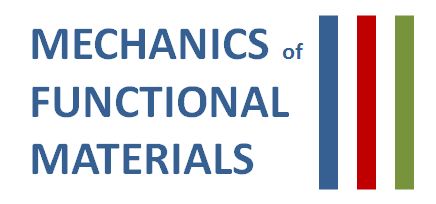-
![]() Picture: MFM/Peter Stein
Picture: MFM/Peter Stein![]() Picture: MFM/Peter Stein
Picture: MFM/Peter SteinThe Influence of Surface Stress on the Chemo-Mechanical Behavior of Inverse-Opal-Structured Electrodes for Lithium-Ion Batteries
2020/01/16
New publication in the Journal of the Electrochemical Society
-
![]() Picture: Qihua Gong
Picture: Qihua Gong![]() Picture: Qihua Gong
Picture: Qihua GongAnisotropic exchange in Nd-Fe-B permanent magnets
2019/12/18
New Publication in “Materials Research Letters”
The exchange is critical for designing high-performance Nd–Fe–B permanent magnets. Here we demonstrate through multiscale simulations that the exchange in Nd–Fe–B magnets. The discovered anisotropic exchange is shown to have profound influence on the coercivity. These findings enable more freedom in designing Nd–Fe–B magnets by tuning exchange. … …
-
![]() Picture: Dominik Ohmer
Picture: Dominik Ohmer![]() Picture: Dominik Ohmer
Picture: Dominik OhmerCalculating the magnetocaloric effect in second-order-type material by micromagnetic simulations: A case study on Co2B
2019/11/05
New Publication in “Scripta Materialia”
We propose a calculation scheme which integrates micromagnetic simulations and the Arrott–Noakes equation for the investigation of the influence of microstructure and magnetocrystalline anisotropy on the magnetocaloric effect (MCE) in second-order magnetic phase transition materials. …
-
![]()
![]()
Modelling the influence of strain fields around precipitates on defect equilibria and kinetics under irradiation in ODS steels: A multi scale approach
2019/09/27
New Publication in “Journal of Nuclear Materials”
The particle-matrix interface in oxide dispersion strengthened (ODS) steels is considered a sink for point defects created during irradiation. In this work we address the question, if elastic strain fields around oxide particles cause a long-range interaction between the precipitates and point defects. …
-
![]()
![]()
Multiscale simulations toward calculating coercivity of Nd-Fe-B permanent magnets at high temperatures
2019/08/10
New Publication in “Physical Review Materials”
A computational scheme integrating the atomistic spin model (ASM) and micromagnetic simulations is proposed to predict the coercivity of Nd-Fe-B permanent magnets at high temperatures. ASM simulations are applied to calculate the temperature-dependent intrinsic parameters of Nd2Fe14B, including the saturated magnetization, magnetocrystalline anisotropy, and exchange stiffness, which are shown to agree well with the experimental values. …
-
![]() Picture: Yangyiwei Yang
Picture: Yangyiwei Yang![]() Picture: Yangyiwei Yang
Picture: Yangyiwei Yang3D non-isothermal phase-field simulation of microstructure evolution during selective laser sintering
2019/08/10
New Publication in “npj Computational Materials”
In this work, we present a three-dimensional finite element phase-field simulation of the SLS single scan, and revealed the process-microstructure relation. We use a thermodynamically consistent non-isothermal phase-field model including various physics (i.e. partial melting, pore structure evolution, diffusion, grain boundary migration, and coupled heat transfer), and interaction of powder bed and laser power absorption. …
-
![]() Picture: Qihua Gong
Picture: Qihua Gong![]() Picture: Qihua Gong
Picture: Qihua GongCalculating temperature-dependent properties of Nd2Fe14B permanent magnets by atomistic spin model simulations
2019/06/03
New Publication in “Physical Review B”
We construct the atomistic spin model Hamiltonian for Nd2Fe14B by using the Heisenberg exchange of Fe−Fe and Fe−Nd atomic pairs, the uniaxial single-ion anisotropy of Fe atoms, and the crystal-field energy of Nd ions, which is approximately expanded into an energy formula featured by second-, fourth-, and sixth-order phenomenological anisotropy constants. …
-
![]()
![]()
Tortuosity but not percolation: design of exfoliated graphite nanocomposite coatings for extended corrosion protection of aluminum alloys
2019/06/02
New Publication in “ACS Applied Nano Materials”
In this article, we explore the corrosion resistance afforded to aluminum alloy AA7075 substrates by unfunctionalized exfoliated graphite nanocomposite coatings as a function of the exfoliated graphite loading. …
-
![]()
![]()
Farewell Banquet in the Division Mechanics of functional Materials
2019/05/17
Congradulation and farewell for Dr. Min Yi and his future career as a professor under the Thousand Youth Talents Program in Nanjing University of Aeronautics and Astronautics (NUAA). …
-
![]()
![]()
Phase-field modeling of non-isothermal grain coalescence in the unconventional sintering techniques
2019/04/29
Upcoming Work
In this work, a non-isothermal phase-field model is developed based on the entropy analysis, which includes contributions from the internal energy (induced by the change of temperature and order parameters) and the order parameter related configurational entropy. It is anticipated that the work could provide a contribution to the research community of unconventional sintering techniques that can be used to model the non-isothermal related microstructural features. …
Division Mechanics of Functional Materials
News Archive
Archive
























